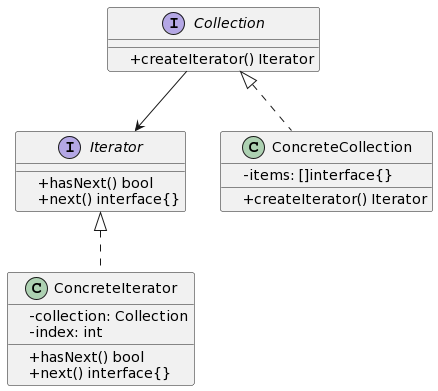1. 什么是迭代器模式
迭代器模式是一种行为设计模式,它提供一种统一的方法来遍历一个聚合对象中的各个元素,而无需暴露该聚合对象的内部表示。
2. 迭代器模式的特点和优点
迭代器模式的特点和优点如下:
- 可以隐藏集合对象的内部结构,使得遍历算法和集合对象解耦。
- 提供了一种统一的方式来遍历不同类型的集合对象。
- 简化了客户端代码,使得客户端代码更加清晰、简洁。
- 可以提供迭代器的不同实现方式,以适应不同的遍历需求。
3. 迭代器模式的实际应用场景举例
迭代器模式在实际应用中有很多场景,例如:
- 遍历一个数据库查询结果集。
- 遍历一个文件系统中的文件和文件夹。
- 遍历一个集合中的元素。
4. Golang中的迭代器模式实现
4.1 UML类图

4.2 示例介绍
在上面的UML类图中,我们有两个主要的角色:Iterator(迭代器)和Collection(可迭代对象)。
- Iterator(迭代器)定义了遍历集合对象的接口,包括
hasNext()方法用于判断是否还有下一个元素,以及next()方法用于获取下一个元素。 - ConcreteIterator(具体迭代器)是 Iterator(迭代器)的具体实现类,实现了
hasNext()和next()方法。 - Collection(可迭代对象)定义了创建迭代器对象的接口
createIterator()。 - ConcreteCollection(具体可迭代对象)是 Collection(可迭代对象)的具体实现类,实现了
createIterator()方法。
4.3 实现步骤
下面我们将逐步实现迭代器模式的 Golang 版本。
4.3.1 定义迭代器接口和具体迭代器类
type Iterator interface {
HasNext() bool
Next() interface{}
}
type ConcreteIterator struct {
collection *ConcreteCollection
index int
}
func (it *ConcreteIterator) HasNext() bool {
if it.index < len(it.collection.items) {
return true
}
return false
}
func (it *ConcreteIterator) Next() interface{} {
if it.HasNext() {
item := it.collection.items[it.index]
it.index++
return item
}
return nil
}
4.3.2 定义可迭代对象接口和具体可迭代对象类
type Collection interface {
CreateIterator() Iterator
}
type ConcreteCollection struct {
items []interface{}
}
func (c *ConcreteCollection) CreateIterator() Iterator {
return &ConcreteIterator{
collection: c,
index: 0,
}
}
4.3.3 在可迭代对象类中实现迭代器生成逻辑
func main() {
collection := &ConcreteCollection{
items: []interface{}{"Golang", "Python", "Java"},
}
iterator := collection.CreateIterator()
for iterator.HasNext() {
item := iterator.Next()
fmt.Println(item)
}
}
运行以上代码,输出如下:
Golang
Python
Java
在以上代码中,我们定义了一个 ConcreteCollection 类,它实现了 Collection 接口,其中的 CreateIterator() 方法返回一个迭代器对象。我们在 main() 函数中使用这个迭代器对象进行遍历操作。
4.4 实现步骤扩展:使用生成器函数简化迭代器实现
在 Golang 中,我们可以使用生成器函数(yield)来简化迭代器的实现。下面是一个使用生成器函数的例子:
func GenerateItems() <-chan interface{} {
items := []interface{}{"Golang", "Python", "Java"}
out := make(chan interface{})
go func() {
defer close(out)
for _, item := range items {
out <- item
}
}()
return out
}
func main() {
for item := range GenerateItems() {
fmt.Println(item)
}
}
在以上代码中,我们定义了一个 GenerateItems() 函数,它返回一个只读通道 (<-chan),在这个函数中使用 yield 将元素依次发送到通道中。在 main() 函数中使用 range 遍历这个只读通道,并输出元素值。
这样,我们就使用生成器函数简化了迭代器的实现。